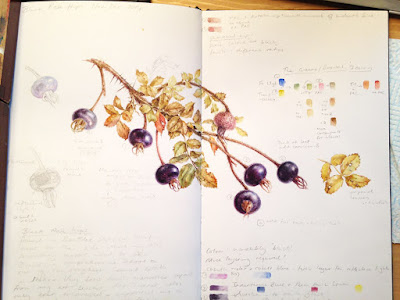 |
| A typical sketchbook entry with drawings, painting, colour testing and annotation |
The importance of keeping a sketchbook should never be underestimated, these precious books can give a real insight into an artists process and their interests, which can often be much more intriguing than a final work! Sketchbooks allow artists to research their subjects and to fine tune observational skills. They facilitate drawing and painting practise without the pressure of producing a finished work. They allow compositional ideas to be formulated. A large body of study material can be created without the commitment of a final piece. Consequently sketchbooks act like an experimental journal, a personal library, from which the artist can pick and choose subjects to take forward.
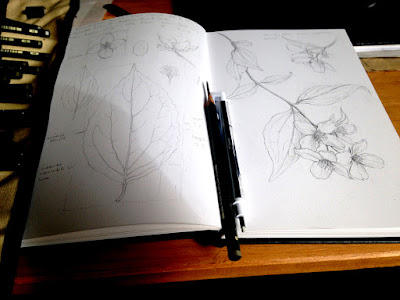 |
| A new sketchbook underway. Stillman and Birn Zeta series are favourites |
With all of this in mind I recently developed a new short course focusing on creating a
botanical sketchbook and also decided to incorporate it into my existing Botanical Illustration Course.
This blog isn't about my work but is for all of the students studying courses with me, and participants will be added as authors. Hopefully they will contribute here to show off their books. But I will kick things off and contribute myself, over time I hope that a thriving collective effort can be created with perhaps a few guest contributors too!
In the past I didn't keep very good sketchbooks but since I started doing so can't think how I managed without them! Every year I used to feel as though so many plants had been overlooked because I simply didn't have time to draw or paint them, for me the sketchbook fills that gap. I believe that my way of 'seeing' and my work have both improved as a direct result and now keep books for a variety of different purposes, some are on specific colours, such as greens, others on certain subjects, such as flower shapes or particular projects ( e.g. graveyard plants) and many more that are just general sketching....basically they include anything I fancy! It's the freedom that really appeals to me and I've also been fortunate enough to be involved in an exciting Sketchbook Exchange project, which is incredibly rewarding. One of the things I really love about sketchbooks is documenting a plant in different phases at different times of year. Then looking back over them. Funny I always seem to recall where I was and what I was doing with sketchbooks. Much more so than with finished works.
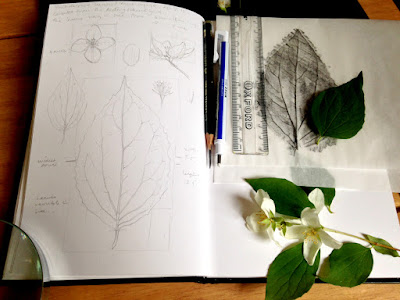 |
| Page 1. Getting to know the plant! Starting with some simple measured line drawings and leaf rubbings. This helps me to get to grips with the basics, here the component parts of a Philadelphus, which grows outside my flat |
For this course I cover the various approaches in graphite and watercolour, including sections working in the field as well as using photo reference. I've worked through the exercises myself before trying it out on the students! and will continue along side the students....It's a learning curve for me too. I also make videos documenting the process and additional materials drawn from other courses. But I'm also open to suggestions and we have a Facebook Group for sharing, discussion and hopefully some development. This is one of my efforts!
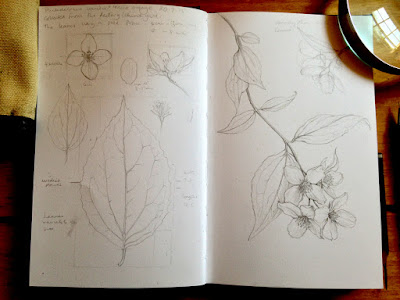 |
| Page 2. Adding a drawing of the typical habit of the plant, a long branch with opposite leaves and multiple flowers at the end |
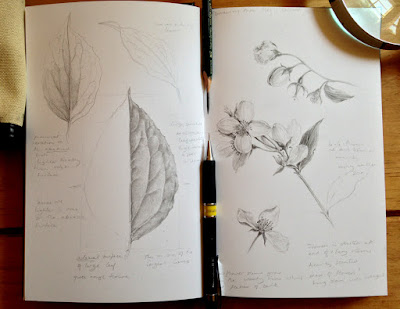 |
| Page 3 and 4. Next up, a bit more detail, some tonal studies of the plant, figure out whats light and whats dark! make descriptive notes of the features. |
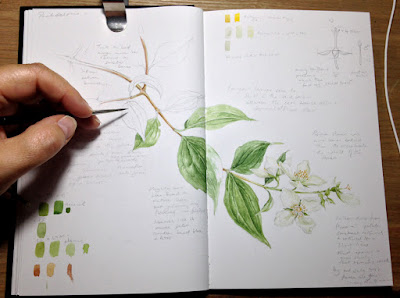 |
| Page 5 and 6. Finally add a colour study. This allows me to work out all of the colour mixes and to try out different approaches and techniques |
The process, I believe, gives me a real insight to a plant. Most of the entries will probably never be used as reference for finished paintings but they document plants that I find of interest but probably wouldn't ever have had the time to paint, some I will no doubt paint in the future. This approach gives me total freedom outside the usual rigour of being a botanical artist and I can add insects and other natural objects that grab my attention. There are no rules about what can and can not be included, there is just a desire to observe, discover and understand. Some entries may make it to study pages and even to final paintings but most of all the sketchbook is about enjoying the process and indulging in it.
........I hope that the Sketchbook students will contribute to this blog documenting their journey too






















